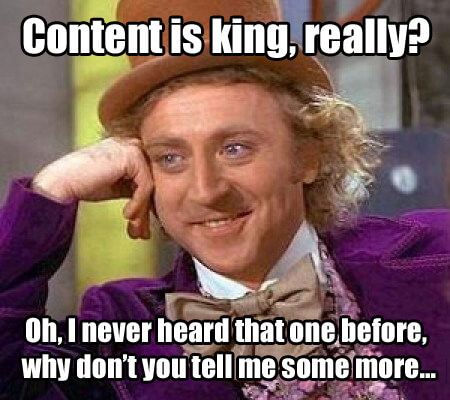
Building a Brand Conscious Content Strategy
In a time when the adage “Content is King” is celebrated over and over as some kind of universal truth (and repeated ad nauseum), many marketers fall into the trap of putting the cart in front of the horse, and producing content for the sake of producing content. Common mistakes include putting quantity over quality, or going for maximum appeal (i.e. the lowest common denominator) instead of the kind of content that their customers (current and potential) will actually engage with.

These kind of common content pitfalls, however, can be avoided by keeping your content strategy focused (and founded) on your brand. Just as your brand offers a unique selling proposition (USP) to its customers (e.g. user experience, loyalty rewards, etc.), so should its content; and by keeping your content strategy informed by your brand’s identity, voice, and USP, you can build a content strategy that helps you capture new customers and retain existing ones.
Defining Your Content’s Brand
Your business has a brand. It might be based on lifestyle, price-point, image, or any other combination of factors, but the point is that your brand has a way of distinguishing itself from the competition.
Well, your content should do so, as well. As Nathan Lump once put it, “Brands should think about what differentiates them, not just from their business competitive set but from their content competitive set.” So your content should not only help your brand further distinguish itself from the competition, but it should have a brand all its own.

For example, when one of our clients, Luxury Retreats, launched the Luxury Retreats Magazine, it’s because they decided to get more aggressive and strategic with their content strategy, and knew that they needed something different than the run-of-the-mill “travel blog + promotions” format that many of their competitors were doing.
They needed something to appeal to luxury travellers (their target market) as both potential customers and as readers and members of the community. In other words, they needed something to (1) make their content stand out from the competitions’, and (2) appeal to their customers in the same way our brand did.
Plan Like a Publisher
When you’re defining your content’s brand, you’re thinking like a marketer. When you’re thinking about a brand, you’re thinking about what you want to say. But a successful content strategy hinges on being able to cultivate and engage an audience, and that means thinking like a publisher. In other words, you have to think about what your readers want to read.

Think of it this way: Conventional mainstream publishers are concerned with selling ad space, and to do so, they create content that will appeal to the kind of readers that their advertisers want to reach. As a branded content publisher, though, you’re focused on selling your brand (and its USP), so you need to create content that will appeal the kind of readers who are likely to engage with your brand.
In other words, you don’t plan a content strategy by finding fun, quirky ways to talk about how awesome your products/services are. You build a content strategy by developing content that appeals to your potential customers by appealing to their capacity to be your customers. For example, if you sell mountain climbing equipment, you don’t blog about how great your ropes and carabiners are; rather, you blog about mountain climbing tips and mountain climbing holiday destinations.
Committing to Your Content’s Brand
An integral part of any brand is consistency. After all, a brand’s strength is determined largely by its ability to consistently deliver on a certain experience and USP. Well, your branded content strategy should be no different, and that consistency should extend to both its quality and frequency.
On the quality side, you can’t ever compromise on your content’s brand. Oftentimes, there’ll be ideas on the table that are a great fit for any publisher in your industry, but if an idea isn’t a good fit for your content’s brand, then you’ll need to learn to pass on it, because you’re not just any publisher.
On the frequency side, you simply have to produce on consistent basis. While publishing once a month probably won’t do much in terms of echoing your brand’s voice throughout the land, you don’t necessarily need to publish five times a day. In fact, in most cases, trying to push the limits inclines you toward the quantity-over-quality bias.
The important thing is that whether you publish daily, weekly, or bi-weekly, you maintain some consistency by building an editorial calendar. In other words, figure out (1) how many times you’re going to publish per month, (2) what topics you’re going to cover, and (3) on what days of the month each piece of content is going to be published and promoted. And then stick to it.
Branded Content & Content Branding
If content truly is King, and you want to reap its benefit and not just be yet another jester, then you have to approach it like royalty. And when you’re royalty, you’re always thinking of dynasty and your legacy — you’re thinking about your brand.
Before embarking on a content strategy, you have to figure out what kind of journey you’re going on, and who you want follow along with you. From there, you can define your branded content’s own brand, and that will allow you figure out everything from what kind of content to produce, who’s managing it, and how it gets produced.